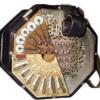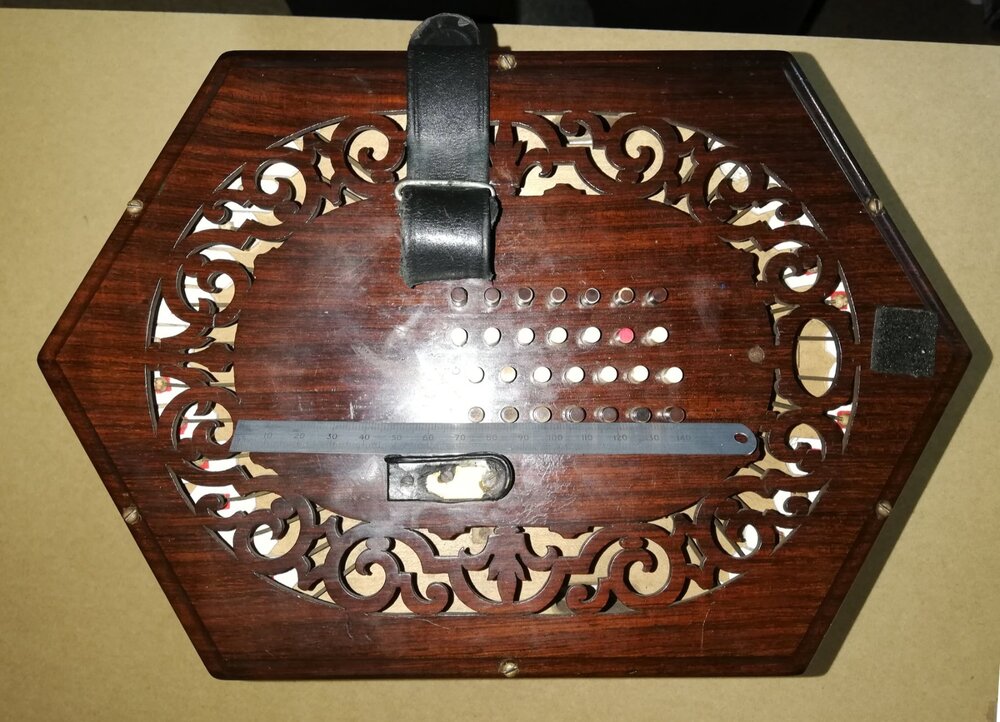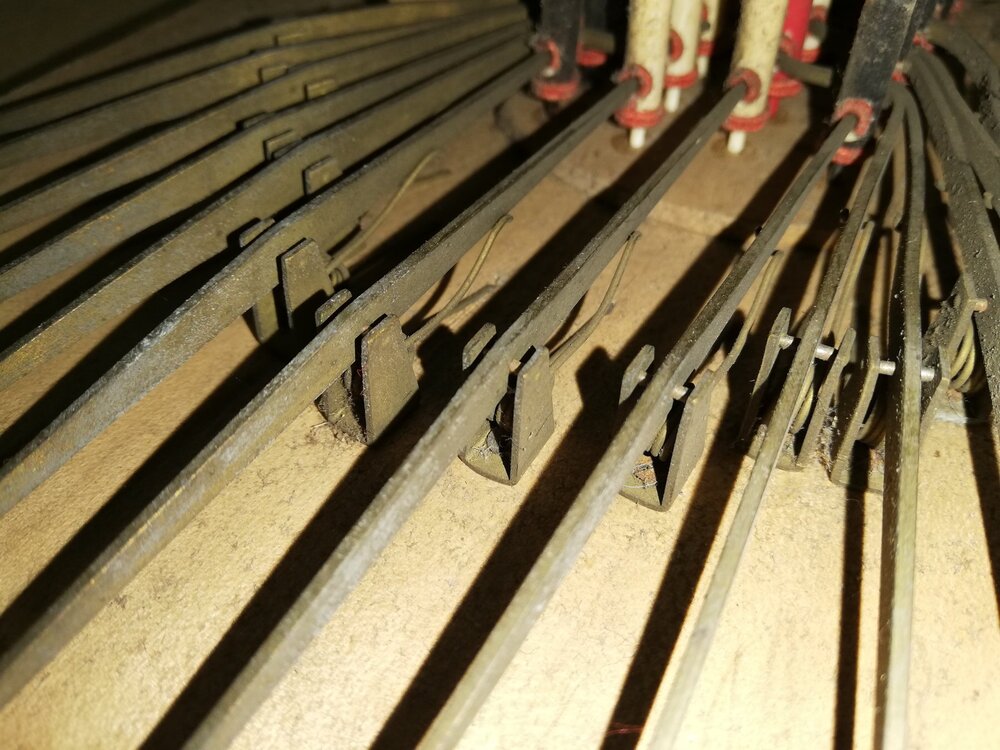-
Posts
1,858 -
Joined
-
Last visited
Everything posted by d.elliott
-
When talking about concertina cases, it is equally important to remember that, not only must the axis of the instrument be horizontal, but the bellows should be firmly held closed. Whilst not good practise to have holding pressure on the keys, I don't see a real technical issue with it. Gig bags, sacks, padded bags may provide protection against shock, but they do not guarantee that the instrument axis is horizontal and that the bellows are held firmly compressed.
-
As an English System player, I have played a number of Morse 'Tinas over the years. I also reviewed the Morse Baritone. I can only agree with Jim that the lower reeds tend to sound a bit more 'not-concertina' than the treble ranges. my other observation is that the lower reeds can flatten with pressure. I know that Anglos are usually played more chordaly so the tendency to over pressure the reeds is much reduced, but please be aware.
-
As Mike says, the concertina should be stored with it's axis horizontal, otherwise the valves are deformed by gravity and will take permanent curl away from the reed pan. This causes all sorts of playing issues and odd popping sounds. Depending on conditions valve life can be reduced by 50% or more. What started as a good idea years ago is death to valves and hence sheep.
-
My thanks to all concerned over the years, will will be missed. Please advise us of the repair and other activities that may survive the loss of manufacturing.
-
Whilst I echo what Theo has said, I wonder if you have a 'set-up' issue. I would strongly advise sitting down, face to face (mask to mask??) with an experienced repairer, with a written list of concerns and your concertina. Gain his/her advice and see what is adjustable and what is just the nature of the instrument. Jeffries are not cheap and it is worth trying to optimise what have as a first instance. Unfortunately perfection does not exist, and all concertinas hold some form of compromises. You have to train your ear, your reflexes and shape your expectations between instruments. In a session you are playing for a cumulative effect, you should not really be able to hear any one specific instrument above the others. It's the music that counts.
-

Dating A Lachenal From The Serial Number
d.elliott replied to johnconstable's topic in Concertina History
Grainne, You are describing a Lachenal 30k Anglo concertina, metal ended and metal keyed. with that serial number the latest information from those who have tracking Lachenal serial numbers/ dating information would put your concertina at Circa 1903. I hope that this helps you. -
12key English Aeola miniature.
-
Difficult to hear on your recording, but I think it is just the natural noise of valves closing. If it is this, then it will not play in. It is the type of valve, and you will get used to it. On traditional instruments the sealing face of the valve is much softer, and valves are easy to change. I think it is the wrong sound for a pad or key base.
-

Adding hand strap for old English concertina
d.elliott replied to Lady's topic in Instrument Construction & Repair
I think you are talking about wrist straps, before you set about buying them you need to establish if your concertina has the mountings provided to accept wrist straps. Please don't just try and screw the straps into place, there is a correct location for the strap mountings and the ends of the strap nearest the thumb strap has an adjustment screw like a smaller version of the thumb strap adjustment screw. You can do harm and devalue your instrument if this is not done correctly. Thumb straps are normally changed as a pair. They are built onto the existing metalwork and are not just leather strapping, but are a leather tube which is assembled around fabric and felt as well as the metal bits, then compressed whilst the glues are wet. -
they are both the same note, same octave.
-
Going through 'stuff' I unearthed a miniature concertina, hidden in a box at the back of a store room. I must have has this instrument around 20 years, put aside awaiting retirement etc etc. The truth is, I am not sure what it actually is. The concertina has 9 folds, metal ends each with 5 keys. Each end has a row of four keys and a second 'row' of a single key centralised on the first row, Thus: o o o o o Each key plays push & pull two notes (Anglo style), there is no air release, it is metal ended, and is is need of new bellows and a total re-working. The action, action boxes, bellows frames, keys etc are intact, and it has a full complement of reeds. I don't know if the reeds are the original and in the original locations. Appended is a sketch of the reedpans & note locations. What does the team think? reed pans mini Anglo.pdf
-

Remove reeds to make air button - any issues..?
d.elliott replied to Steve Mansfield's topic in General Concertina Discussion
You do not need an air release to open and close a concertina silently, or quickly for that matter. If you doubt me then contact Alister Anderson who showed a class that I was in many years ago. Since then I just don't use air buttons. -
I agree with Clive, it seems silly to destroy an otherwise reasonable instrument for the sake of bellows.
-

Replacement concertina buttons
d.elliott replied to JJArn's topic in Instrument Construction & Repair
You may well need to send a sample of yet another button to be matched. There was no such thing as a standard concertina key, any more than a standard concertina end bolt. If you don't want to send a button and risk loosing another one then the following needs to be provided: 1: photo showing clearly the shape of the crown of the cap. 2. the length of the cap 3. the diameter of the cap, use a Vernier calliper or equivalent, decimals of a mm are important. 4. the length of the key, base to crown, (ignoring the guide peg) 5. the length of the guide peg 6. the diameter of the guide peg 7. the distance from the base of the key to the centreline of the cross hole. All these things are variables that can be the difference between an easy fit and more frustration. You might like to publish the information here, someone might have something to help you with. -
Thanks Bill, A bit of a conundrum, but a super instrument.
-
Thanks Mike, the owner believes that this is a Wheatstone too, but we seek conformation. I have look at Chris Flint's essay on concertina actions, there are plenty of options, including several Wheatstone's variants, but nothing like this.
-
The items that need replacement most frequently are the valves.
-
Certain items in a concertina's build are what engineers call 'consumable' items, they have a life and are then replaced when life is expired. Like tyres on a car, fundamental to performance but can be changed when worn out or if driving conditions/ expectations change. Valves, pads are the obvious concertina items, but so are springs, and yes, bellows. All are throw away items. The trick is to get bellows of the appropriate standard for the instrument and your own playing needs; and to decide what 'enhancements' you may want to incorporate. A Four or Five folds to upgrade to say six folds? Get the bellows made and fitted by someone who knows the difference in the requirements for Anglos versus English instruments and knows what leather to use. However there are options to consider before the expense of new bellows, if the issue is just wear around the points of the folds then re-binding may be a sensible option to buy a few years. Wear in the gussets can be repaired internally. Internal hinges that split can lead to almost irreparable damage, but if caught early enough can fixed with (sticky) ease. External valley leather hinges are not good to repair and are usually a good indicator that the leather has 'gone home'. Collapsed bellows corners resulting from delaminated card, perished, contaminated and powdery leather all leave no real repair options. Certainly none with any confidence of longevity especially with constant play in mind. As John says, it's the ends and reeds that make the instrument. bellows can can only spoil or enhance it - cosmetically and in performance so thus maximising or detracting from value.
-
Stephen, the ends are marked R & L conventionally. I have also appended a picture of the RH side fretwork as requested by Sean. you can see that the centre line of the thumb strap aligns with the D row in the conventional manner. This concertina was designed and built to be what it is, a C bass. No reeds have been moved. It is a fine instrument to play.
-
Yes it is a 'C' Bass, therefore an English system and in this case single action. I last had this instrument on my work bench 24 years ago and it has been played regularly ever since. The concertina is back in for bellows problems and a bit of a tune up. Whilst the concertina is here I am trying to establish, on behalf of the owner as well as for my own education, a bit more about about its antecedents in terms on manufacture and design.
-
Don, extremely stable, no lateral twisting or migration of the arm along it's 'axle'. Each assembly is screwed into place on the action board. the whole thing is very robust.
-
Attached is a photo of an action style that I have only seen once before, many years ago. The serial number stamped inside is 1984. The reeds are all surface mounted brass, and the reed frames are square at each end. The stampings on the reed frames are FA, SOL, SI, DO, RE(accented) etc. so possibly French made. The instrument is well made in all respects. So team, any ideas of manufacturer and vintage?
-
Dabbler, experience has taught that, as leather gasketing clamped up firmly can act like a bond to the underside of the padboard, then so can fresh polish. With the ebony trim around the action box split line I cannot tell which side of the trim is the split line. I think that the OP needs to find this out before he can progress with the problem of opening the action box to access the springs, keys and end plate bushings.
-
I would try taking the other end off and releasing the screws to see if the split line is more obvious.
-
have you released the middle screw of the finger slide? under the leather facing. why do you feel the need to adjust a spring?





